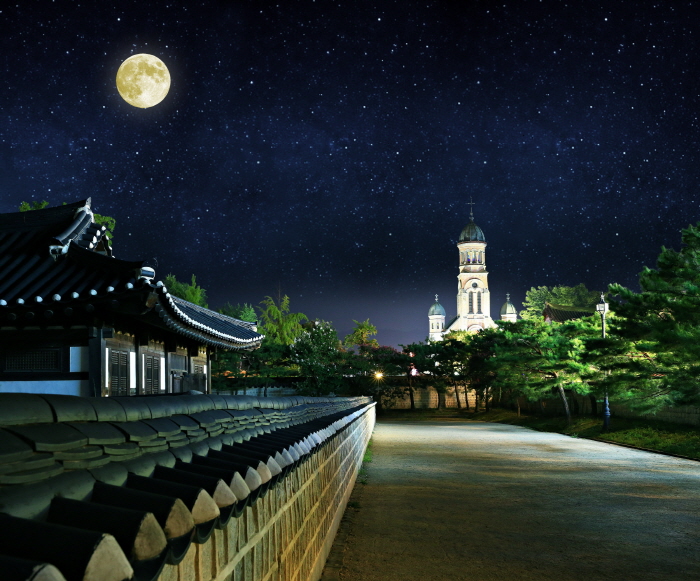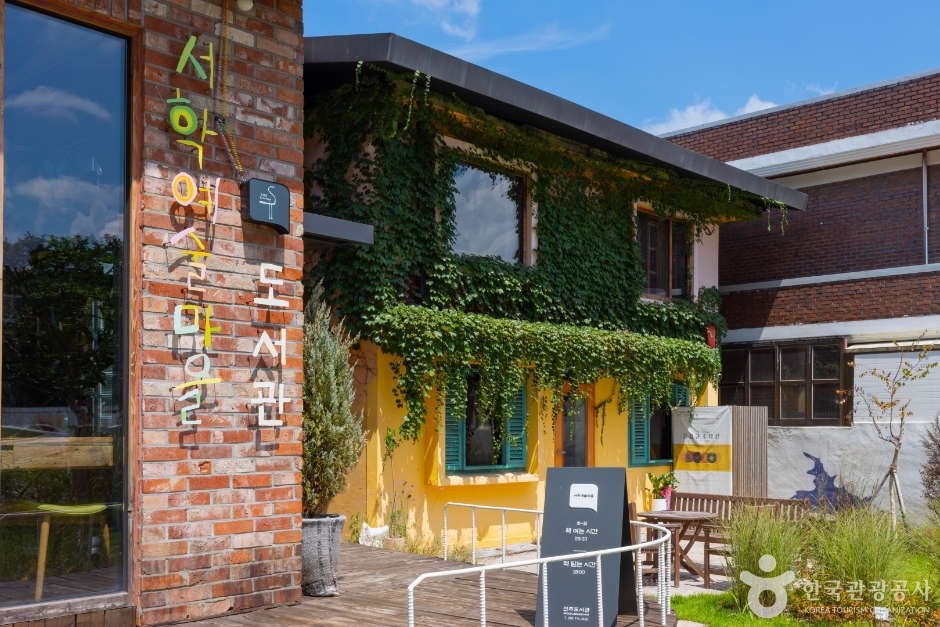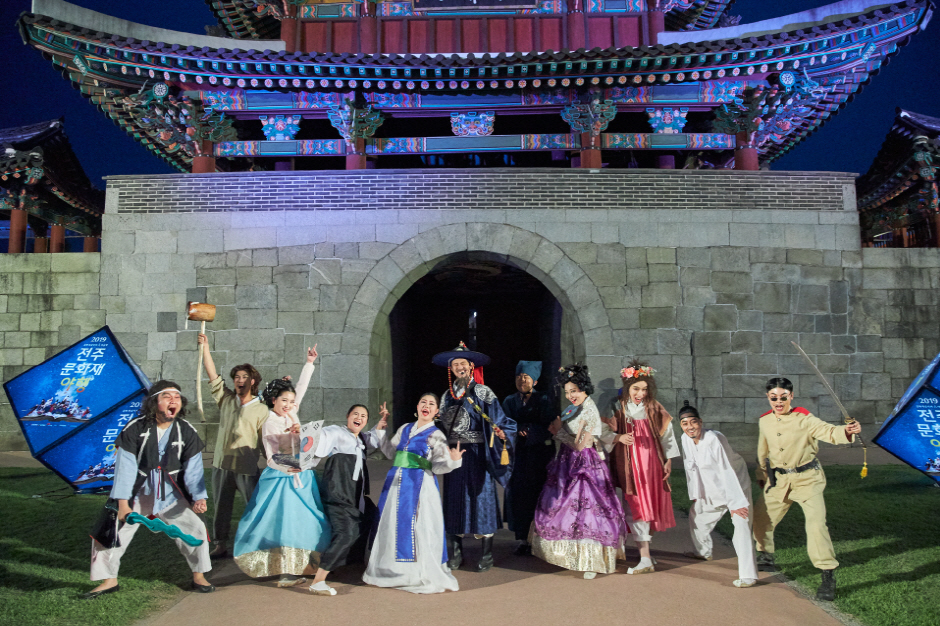Promenade avec roi (전주 한옥마을 경기전 '왕과의 산책')
488.0704680726087m 5478 2024-04-07
44, Taejo-ro, Wansan-gu, Jeonju-si, Région Jeonbuk
+82-63-232-9938
Le programme "Promenade avec roi" se déroule tous les samedis soirs à Gyeonggijeon. Il s'agit d'une nuit spéciale prévue pour 100 personnes à chaque séance ! Vous pouvez faire l'expérience de la vie sous la dynastie de Joseon sous la lumière de la lune tout en prenant une tasse de thé. De la musique et des guides vous accompagneront également pendant votre visite.
Bibliothèque du village des arts Seohak (서학예술마을도서관)
488.0227799638897m 0 2024-04-08
12-1, Seohak-ro, Wansan-gu, Jeonju-si, Région Jeonbuk
La bibliothèque du village des Seohak a ouvert en juin 2022 à Jeonju, dans la région Jeollabuk-do. L'établissement abrite près de 1000 livres. Le site est réputé pour ses belles décorations. La biblithèque se situe dans un ancien bâtiment qui servait autrefois de café et de galerie faisant de l'endroit davantage un 'book café' qu'une bibliothèque.
Hanokhyeyum[Korea Quality] / 한옥혜윰[한국관광 품질인증/Korea Quality]
489.44206128217513m 103 2024-04-07
42-5, Hyanggyo-gil, Wansan-gu, Jeonju-si, Région Jeonbuk
+82-10-5512-1226
Located in Jeonju Hanok Village, Hanok Hyeyum offers a traditional “hanok” (traditional Korean house) experience to its guests. The Korean term “hyeyum” means “thought,” and the hostel’s name pertains to the owners’ wishes of providing new feelings and thoughts to visitors. Its design faithfully brings the feel of the grain on the timber, which was possible with the participation of Daemokjang and Somokjang artisans specializing in hanok construction. The hanging sign at the entrance is carved by a Mokjogakjang, an artisan carpenter and holder of Intangible Cultural Property, and the same spirit of dedication and passion can be found throughout the building. There are six rooms in total, all Korean-style with exposed rafters, handwritten calligraphy, dainty furniture, and masterful teacups. Guests can also find a surprise welcome package of face mask packs. All rooms have modern and sleek bathrooms, while some rooms come with small attic spaces. Hanok Hyeyum also offers pickup services to solo female travelers from the Jeonju Bus Terminal or Jeonju Station, and a complimentary breakfast with a seasonal menu, including items like rice cakes, egg, sweet potato, fruits, and coffee.
Voyage nocturne à Jeonju (전주 문화재야행)
493.91474963933706m 6653 2024-04-07
44, Taejo-ro, Wansan-gu, Jeonju-si, Région Jeonbuk
+82-63-232-9937
<Le voyage nocturne à Jeonju (Jeongjuyahaeng, 전주야행夜行)>
Ce programme vous permet d'apprécier les centaines de hanok du village de Jeonju et ce au clair de lune. Le voyage nocturne à Jeonju permet ainsi d'apprécier les principaux patrimoines culturels de la ville de Jeonju. Ce programme vous permet de découvrir les histoires cachées de la ville de Jeonju et son patrimoine culturel dans sa globalité.
Hanok Garden in Jeonju [Korea Quality] / 전주한옥마당 [한국관광 품질인증]
498.83336477701937m 249 2024-04-07
80-13, Jeonjucheondong-ro, Wansan-gu, Jeonju-si, Région Jeonbuk
+82-10-9494-4579
Jeonju Hanok Madang is located in the Jeonju Hanok Village. Jeonjucheon Stream and Namcheongyo Bridge are only one block away, whereas Gangam Calligraphy Museum, Jeonjuhyangyo Confucian School, Jeonju Hanbyuk Culture Center, Nambu Market, and Markbu Market Youth Mall are nearby. Major attractions of the Jeonju Hanok Village such as Gyeonggijeon, Jeondong Catholic Cathdral, and Omokdae are also within walking distance.
The main building and servants’ quarters of Jeonju Hanok Madang were built in 1941. It was renovated to retain the original shape of the traditional hanok, yet cozy and comfortable enough for modern people to use. Porches are attached to every room while Faith Room and Hope Room have additional inner floors attached to it. Inside the rooms are rafters, beams, wooden pillars walled with Hanji wallpapers, and ribs of lattice doors. There is a clean bathroom in each room.
The yard is the place the owner couple cherishes the most. Guests can enjoy the yard in any room just by opening the door. It is a combination of jar stands, a small pine tree, and small potted plants. Different flowers bloom from spring through autumn. It is such a pleasure to sit on the porch and appreciate the scene. In autumn, the persimmon tree bears fruits and dried persimmons hang from the eaves.
Yeohangga [Korea Quality] / 여행가 [한국관광 품질인증]
503.36266008534477m 9718 2024-04-07
74-11, Eunhaeng-ro, Wansan-gu, Jeonju-si, Région Jeonbuk
+82-63-231-3040, +82-10-7742-6738
Yeohangga is a guesthouse owned and run by a woman who majored in early childhood education and who has been teaching children for over 20 years. The name means "A home for a happy trip," she says. It’s a unique guesthouse since the owner offers various traditional educational games. The cozy and comfortable guesthouse is a traditional Korean house built in March 2013 at a site where an old house used to be. The main building and detached building are divided by the ridge of the roof with beautiful rafters. There is another meaning to the name of the guesthouse: "a house where the woman is happy." She named it as such for a good reason. She used to live in Seoul when her parents advised her to move to Jeonju and run a guesthouse, leaving her husband and child behind. At first, she considered accepting only female guests, but it wasn't an option since most of the people visiting Jeonju are couples and groups of friends. Instead, she made sure the guesthouse is safe for women while building the house. Many female tourists traveling alone find this a great feature of the guesthouse because they feel safer during their stay. For one, she installed three doors for the rooms (1 transparent door, 1 opaque glass door, and a traditional Korean door). Not only do the guests feel safer; the rooms are also well-insulated thanks to the triple doors. The floors and walls are covered with traditional Korean paper coated with soybean oil, which is very environment-friendly. In the four rooms named “Spring,” “Summer,” “Autumn,” and “Winter,” there are many toys and materials for traditional Korean cognition games, such as “Chilgyo Game,” “Gonu Game,” and “Mabangjin.” It’s very likely that even Koreans have never heard of these games. The owner of the guesthouse chose these games specifically because they are perfect for children to play in a traditional Korean house. She teaches her little guests how to play the games. “Chilgyo Game” involves making a shape with 7 to 20 pieces, whereas “Gonu Game” is similar to the game of Chinese chess. "Mabangjin" is a type of IQ game that involves laying down a total of nine different numbers in three rows and columns so that the sum of the three numbers is identical when added horizontally, vertically, or diagonally. Many guests find these games interesting, and the owner of the guesthouse finds joy in teaching these games to as many families as possible. She recently took over another traditional Korean guesthouse called "Samrakheon" near the Jeonju Oriental Medicine Center. It's a stand-alone guesthouse for groups and families, and she uses the place to teach traditional games to more people.
ONEWWAL[Korea Quality] / 오뉴월[한국관광 품질인증/Korea Quality]
508.0855675890912m 101 2024-04-07
51-5, Hyanggyo-gil, Wansan-gu, Jeonju-si, Région Jeonbuk
+82-10-3670-2581
Onyuwol is a “hanok” guesthouse located in Jeonju Hanok Village. It is attached to a café that combines hanok and modern interior design and has enjoyed considerable popularity via word-of-mouth among young travelers. There are five rooms in total, which are furnished comfortably like their namesakes (the months of May and June). The rooms bear the hallmark elegance of hanok, from their exposed rafters to red clay floors, white cotton beddings, and muslin curtains. The furnishings remained minimalist, with only bedding, a small TV, electric kettle, and a basket containing a towel, hairdryer, and a hand mirror. The sleep-themed room names show that they are furnished with a restful stay in mind. Opening the door brings guests to the view of the peaceful garden. Nabijam and Kkotjam rooms have small attics that add a layer of elegance, while only the Danjam room is furnished with a bed. All rooms are equipped with bathrooms. Guests can also enjoy a complimentary cup of Americano in the café, and international guests have access to English services. Furthermore, its location makes it a good starting point for visits to Jeonju’s major tourist sights, such as Jeonjuhyanggyo Local Confucian School, Gyeonggijeon Shrine, Omokdae Historical Site, or the alleyways of the historical city.
Damun (다문)
524.0406889102325m 8127 2024-04-07
74-8, Eunhaeng-ro, Wansan-gu, Jeonju-si, Région Jeonbuk
+82-63-288-8607
Situated in Jeonju Hanok Village, Gyo-dong, Jeonju-si, Damun serves Korean table d’hote in a restaurant divided into large and small rooms within a hanok building structure.
The Hanok [Korea Quality] / 더 한옥 [한국관광 품질인증]
532.7368221817296m 875 2024-04-07
68-15, Eunhaeng-ro, Wansan-gu, Jeonju-si, Région Jeonbuk
+82-10-2189-4002
The Hanok was transformed into a new style of hanok by combining the traditional structure (built in 1975) with a modern hanok style. Located in Jeonju Hanok Village, this large hanok is composed of a ‘ㄱ’-shaped bonchae (main building, 7-kan*), a sarangchae (men’s quarters, 3-kan), a large courtyard, and a platform for crocks of sauces and condiments. The house accepts only a limited number of people so that guests can enjoy a relaxing stay amid a pleasant, spacious environment.
Each room is built with “well-being” construction materials such as Hinoki cypress wood, red clay, and hanji (traditional Korean paper handmade from the mulberry tree). As for the four rooms of the anchae (women’s quarters), ‘Gwibin’, the largest room, is suitable for two families. It is heated with the ondol system (Korean floor heating system), and has a body massager and two king-sized beds. ‘Eoulim’ has an attic and a high ceiling with exposed rafters and crossbeams. Both rooms are equipped with two bathrooms.
The ‘ㅡ’-shaped sarangchae opposite the courtyard has three guestrooms. In particular, ‘Byeolhana’ has a red clay bed with ondol heating; while ‘Byeolset’ features a bunkbed made of wooden materials originally used in the construction of the house.
The Hanok provides a ‘Moonlight tea meeting’ where guests can enjoy tea and conversation under the moonlight in the large courtyard.
*kan - a unit of measurement referring to the distance between two columns.
Musée de la calligraphie Gangam (강암서예관)
535.4913809482833m 3704 2024-04-07
74, Jeonjucheondong-ro, Wansan-gu, Jeonju-si, Région Jeonbuk
+82-63-285-7442
Inauguré en 1995, le musée Gang-am est un établissement spécialisé en calligraphie. Situé dans le village des hanok (maisons traditionnelles coréennes) de Jeonju, il expose environ mille œuvres de calligraphes illustres tel que Kim Jeong-Hui (1786-1856, peintre, calligraphe et savant), Lee Sam-Man (1770-1845, calligraphe), Kim Hong-Do (1745- ?, peintre), Jeong Yak-yong (1762-1836, savant), etc.. Le musée s’étend sur 872 ㎡, il comporte des salles d’expositions et des salles de conférences. Sa collection comprend 1.162 pièces.



![Hanok Garden in Jeonju [Korea Quality] / 전주한옥마당 [한국관광 품질인증]](http://tong.visitkorea.or.kr/cms/resource/43/2594443_image2_1.png)
![Yeohangga [Korea Quality] / 여행가 [한국관광 품질인증]](http://tong.visitkorea.or.kr/cms/resource/63/2572563_image2_1.jpg)
![ONEWWAL[Korea Quality] / 오뉴월[한국관광 품질인증/Korea Quality]](http://tong.visitkorea.or.kr/cms/resource/97/2651897_image2_1.jpg)

![The Hanok [Korea Quality] / 더 한옥 [한국관광 품질인증]](http://tong.visitkorea.or.kr/cms/resource/68/2556468_image2_1.jpg)

 Français
Français
 한국어
한국어 English
English 日本語
日本語 中文(简体)
中文(简体) Deutsch
Deutsch Español
Español Русский
Русский